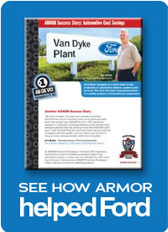 |
||
 |
||
|
SHIPPING CONTAINER POSITION AND CONTENTS AND THEIR IMPACT ON CORROSION FORMATION In the June ARMOR SENTINEL, the Corrosion College article featured issues surrounding temperature and humidity fluctuations during overseas shipments. We continue to look at overseas shipments in this month's article as we analyze the effects of container position and content, variables that are equally important. If you are in the metalworking business, chances are you have had corrosion during ocean shipments and you have probably had to design a rust preventive solution to deal with it. Some of these variables are known or identifiable making them easier to address, while others are hardly known and nearly impossible to control. The following data summarizes the results from ocean container temperature and humidity conditions for shipments between Asia, Europe and North America. The effects of container position on the ship and recorder position within the container are presented. The effects of the container contents are also discussed. Effect of Position on Ship
As part of the study “Temperature & Humidity in Ocean Containers” by David Leinberger, CPP, CPLP, Senior Packaging Engineer for Xerox Corporation, the conditions in multiple ocean shipping containers traveling on the same ship were measured. The temperature fluctuations were nearly identical for those containers who were covered or shielded from the sun by other containers during shipment. However, there were clear differences in temperature between the shipping containers located in areas of the boat where sun exposure was greatest.
The graph titled "Figure 10: Container Temperature Differences from Same Ship" compares two shipping containers from the same ocean journey. Container #1 was loaded above deck where the sunlight could affect the container temperature, while container #2 was covered by other containers. The graph demonstrates how container #2 had a gradual temperature variation along the ocean journey, while container #1 experienced a much larger variation each day. It is believed that because container #2 was covered or shielded by other containers, the shadow created by the other containers helped to moderate or temper the container temperatures causing less variation. It is important to note that the temperature variations while at sea are actually more moderate than those seen before and after the ocean journey in the container. Of course ocean transport usually lasts for a much longer duration. Those who read June's Corrosion College column titled "Oneth By Land and Twoeth by Sea - Corrosion Damage Does Not Discriminate," may recall the influence of temperature fluctuations on corrosion rates and corrosion rates directly impact a company's bottom line. Shipment container position on the ship is probably one of the toughest variables to address because it is almost impossible to control, but it does play a critical role in the final outcomes. This is not great news, but it is better to be aware than ignore it. This also explains why some ground shipments present more rust issues than ocean shipments--a container on a truck gets as much sunlight as a shipping container located in the top position on an overseas ship. Effect of Position Within Container At any given temperature the air can only hold a specific amount of water vapor (humidity). A typical shipment will see an increase in humidity and condensation as the temperature drops within a container. However, for containers that contain porous packaging materials, humidity stabilizes and eventually falls even as the temperature continues to drop. This occurs because the porous materials present in the packaging, such as corrugated boxes, paper, wooden skids, slowly absorb the moisture from the air preventing condensation at the lower ocean temperatures. This event usually happens during night hours. Effect of Container Contents
This information reveals why for many auto-parts manufacturers condensation and corrosion issues occurred when they switched from corrugated boxes to returnable plastic dunnages. Reusable plastic trays are not only a well known source of contamination, but they also don’t absorb moisture. This variable is the easiest to control when compared to the others introduced in this article. As a general rule, every rust preventive solution should find a way to fight against condensation issues, whether it is VCI paper or desiccant, especially when the packaging has a high content of plastic materials. Conclusions Since we cannot control the position of the container on the ship or the position of the pallet within the container, it is important to select strong protective packaging solutions that will preserve and protect. Barrier products such as ARMOR's Defender™ or Crusader™ film will help to isolate metal parts from the harsh environment and minimize the effect of unpredictable variables. It is also important to find a way to deal with the humidity within the packaging, especially when it contains a high content of plastic such as poly film, returnable dunnage, etc. ARMOR offers solutions such as ARMOR WRAP® paper or desiccant, both absorb excess moisture within the package. In addition, ARMOR WRAP® paper offers the protection of ARMOR's proprietary VCI which becomes more active in the presence of moisture. As moisture and temperature increase the vaporization rate of the VCI formulation components also increase. Uniquely, ARMOR’s VCI Nanotechnology responds and adjusts to temperature and humidity fluctuations, increasing and decreasing as needed. For additional information on international shipment and packaging options, visit the ARMOR website at www.armorvci.com or contact your ARMOR sales representative. |






